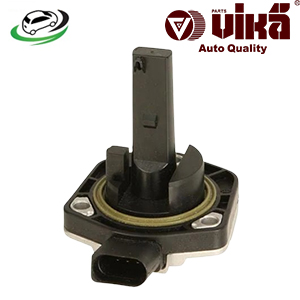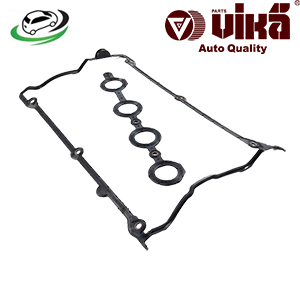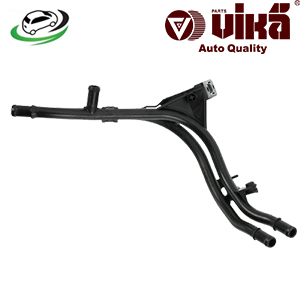-13%
Get Engine Coolant Water Pipe AUDI A3/Q3/TT / VW Passat/Tiguan/Golf 1K0121070BD
An engine coolant water pipe is a critical component of a vehicle’s cooling system, responsible for transporting coolant between the engine and the radiator, and to various parts of the engine to maintain optimal operating temperatures. This comprehensive overview will cover the construction, function, benefits, common issues, signs of failure, and maintenance of engine coolant water pipes.
Construction and Function of an Engine Coolant Water Pipe
Construction:
- Materials:
- Metal: Many coolant pipes are made from aluminum or steel, offering durability and resistance to high temperatures.
- Rubber: Flexible rubber hoses are commonly used for sections requiring flexibility, such as connections between the engine and radiator.
- Plastic: Some modern vehicles use high-temperature-resistant plastics, which are lighter and resistant to corrosion.
- Design:
- Shape and Size: Coolant pipes are designed in various shapes and sizes to fit specific vehicle models and engine configurations. They often include bends and curves to navigate the engine bay.
- Reinforcements: Some coolant pipes are reinforced with internal structures or external sheaths to withstand pressure and prevent kinks.
Function:
- Coolant Transportation:
- Circulation: The primary function of the coolant water pipe is to circulate coolant through the engine and radiator. This circulation helps absorb heat from the engine and dissipate it through the radiator.
- Temperature Regulation: By moving coolant efficiently, the pipes help maintain a consistent engine temperature, preventing overheating and ensuring optimal performance.
- Connection Points:
- Engine Block: Coolant pipes connect to the engine block to carry heat away from the combustion process.
- Radiator: They connect to the radiator, where the heat is transferred from the coolant to the air.
- Heater Core: Some pipes also route coolant to the heater core to provide cabin heating.
Benefits of an Engine Coolant Water Pipe
- Efficient Cooling:
- Temperature Control: Coolant pipes play a vital role in regulating engine temperature, preventing overheating, and ensuring the engine runs efficiently.
- Heat Dissipation: They facilitate the transfer of heat from the engine to the radiator, where it can be safely dissipated.
- Engine Protection:
- Preventing Overheating: By ensuring consistent coolant flow, the pipes help prevent engine overheating, which can cause significant damage and reduce engine lifespan.
- Reducing Wear: Maintaining optimal temperatures reduces wear and tear on engine components, contributing to longer engine life.
- Performance Optimization:
- Consistent Operation: Properly functioning coolant pipes help the engine operate within its designed temperature range, ensuring optimal performance and fuel efficiency.
- Enhanced Reliability: Reliable coolant circulation leads to fewer breakdowns and maintenance issues.
- Environmental Benefits:
- Emission Control: Efficient cooling helps the engine maintain proper combustion temperatures, reducing harmful emissions.
- Fuel Efficiency: Optimal engine temperatures contribute to better fuel efficiency, reducing the overall environmental impact.
Common Issues with Engine Coolant Water Pipes
- Leaks:
- Cracks and Holes: Over time, coolant pipes can develop cracks or holes, leading to coolant leaks. Metal pipes may corrode, while rubber hoses can degrade and split.
- Loose Connections: Connections between pipes and components can become loose, causing leaks at the joints.
- Blockages:
- Debris and Sludge: Contaminants such as debris or sludge can accumulate inside the pipes, restricting coolant flow and reducing cooling efficiency.
- Scale Build-Up: Mineral deposits from the coolant can build up over time, leading to blockages.
- Wear and Tear:
- Aging Materials: Rubber hoses can become brittle and lose flexibility over time, while metal pipes can corrode.
- Mechanical Damage: Pipes can suffer from physical damage due to engine vibrations, impacts, or improper installation.
- Temperature Extremes:
- Heat Damage: High engine temperatures can cause materials to degrade faster, especially in areas close to the exhaust manifold or turbocharger.
- Cold Cracking: In cold climates, rubber hoses may become less flexible and more prone to cracking.
Signs of Failing Engine Coolant Water Pipes
- Coolant Leaks:
- Puddles Under the Vehicle: Visible coolant puddles under the vehicle can indicate a leak in the coolant pipes.
- Low Coolant Levels: Frequent low coolant warnings may suggest a leak.
- Overheating:
- Temperature Gauge: A rising temperature gauge on the dashboard can indicate insufficient coolant flow due to a failing pipe.
- Warning Lights: The engine warning light or coolant temperature warning light may illuminate.
- Visible Damage:
- Cracks and Holes: Inspection of the coolant pipes may reveal visible cracks, holes, or signs of corrosion.
- Bulging or Swelling: Rubber hoses may appear bulged or swollen if they are deteriorating internally.
- Engine Performance Issues:
- Poor Performance: An overheating engine may perform poorly, with reduced power and efficiency.
- Strange Noises: Gurgling or hissing sounds can indicate coolant leaks or air entering the system.
Maintenance and Replacement of Engine Coolant Water Pipes
- Regular Inspections:
- Visual Checks: Regularly inspect the coolant pipes for signs of wear, damage, or leaks.
- Coolant Levels: Check and maintain proper coolant levels, and look for signs of contamination in the coolant.
- Timely Replacement:
- Replace When Worn: Replace coolant pipes at the first sign of wear or damage to prevent leaks and overheating.
- Use Quality Parts: Opt for high-quality replacement parts that meet or exceed the original specifications.
- Professional Service:
- Expert Diagnosis: Have a professional diagnose any cooling system issues to ensure accurate identification of problems.
- Proper Installation: Ensure that replacement pipes are properly installed to avoid leaks and ensure efficient coolant flow.
- Routine Maintenance:
- Coolant Flushes: Regularly flush the cooling system to remove contaminants and prevent blockages.
- Monitor Conditions: Keep an eye on operating conditions, especially in extreme temperatures, and take preventive measures to protect the pipes.
Follow us on Facebook for more parts.



